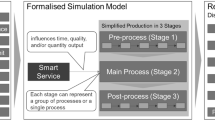Abstract
Today’s manufacturing companies are confronted with key challenges such as an increasing individualization and shorter product life cycles. Production systems are to be made resistant to substitutions in order to secure sustainable competitive advantages in such a volatile market environment. A production system runs at risk of being substituted if an alternative production system exists, which is at least equivalent in terms of economic, ecologic, social, and technological criteria with respect to current as well as possible future product programs. The research presented in this paper provides a systematic approach to assess the substitution risk of production systems regarding a current as well as possible future product programs. It comprises a methodology, which allows for a static and dynamic evaluation of production systems based on analytical cost models, scenario creation and real options analysis. By implementing a Monte Carlo simulation, various probability distributions of system parameters can be taken into account. The presented methodology focusses on economic and ecologic aspects. Finally, the methodology is applied to a case study.










Similar content being viewed by others
References
Abele E, Liebeck T, Wörn A (2006) Measuring flexibility in investment decisions for manufacturing systems. CIRP Ann Manuf Technol 55(1):433–436. doi:10.1016/S0007-8506(07)60452-1
Koren Y, Heisel U, Jovane F, Morwaki T, Pritschow G, Ulsoy G, Van Brussel H (1999) Reconfigurable manufacturing systems. CIRP Ann Manuf Technol 48(2):527–540. doi:10.1016/S0007-8506(07)63232-6
Westkämper E (2007) Digital manufacturing in the global era. In: Cunha PF (ed) Digital enterprise technology: perspectives and future challenges. Springer, New York, pp 3–14
Klocke F, Trommer G (2001) Methodology for the generation and assessment of alternative manufacturing sequences in early phases of product development. Prod Eng 8(1):99–102
Gole W, Hilger PJ (2009) Due diligence. An M&A value creation approach. Wiley, Hoboken
Gregoriou G, Renneboog L (2007) Corporate governance and regulatory impact on mergers and acquisition. Research and analysis on activity Worldwide since 1990. Elsevier, Burlington
Milberg J, Möller N (2008) Valuation of changeable production systems. Prod Eng Res Dev 2(4):417–424. doi:10.1007/s11740-008-0133-1
Maier-Speredelozzi V, Koren Y, Hu SJ (2003) Convertibility measures for manufacturing systems. CIRP Ann Manuf Technol 52(1):367–370. doi:10.1016/S0007-8506(07)60603-9
Ceryan O, Koren Y (2009) Manufacturing capacity planning strategies. CIRP Ann Manuf Technol 58(1):403–406. doi:10.1016/j.cirp.2009.03.034
Ko J, Hu SJ, Huang T (2005) Reusability assessment for manufacturing systems. CIRP Ann Manuf Technol 54(1):113–116. doi:10.1016/S0007-8506(07)60062-6
Lanza G, Sauer A (2012) Simulation of personnel requirements during production ramp-up. Prod Eng Res Dev 6(4/5):395–402. doi:10.1007/s11740-012-0394-6
VDI Verein Deutscher Ingenieure (1990) Wirtschaftliche Grundlagen für den Konstrukteur (2234). Accessed 8 2012
Buchholz SH (2014) Bewertung des Substitutionsrisikos von Fertigungssystemen. Dissertation, RWTH Aachen University
Müller S (2007) Methodik für die entwicklungs-und planungsbegleitende Generierung und Bewertung von Produktionsalternativen. Dissertation, Universität München
Klocke F (2011) Manufacturing processes 1. Cutting. Springer, Berlin
Gassmann O (2006) Innovation und Risiko: zwei Seiten einer Medaille. In: Gassmann O, Kobe C (eds) Management von innovation und Risiko. Springer, Berlin, pp 3–27
Gausemeier J, Fink A, Schlake O (1998) Scenario management—an approach to develop future potentials. Technol Forecast Soc Change 59(2):111–130. doi:10.1016/S0040-1625(97)00166-2
Schuh G, Schultze W, Schiffer M, Rieger A, Rudolf S, Lehbrink H (2014) Scenario-based determination of product feature uncertainties for robust product architectures. Prod Eng Res Dev 8(3):383–395. doi:10.1007/s11740-014-0532-4
Nau B (2012) Anlauforientierte Technologieplanung zur Auswahl von Fertigungstechnologien. Dissertation, RWTH Aachen University
Schindler S (2014) Strategische Planung von Technologieketten für die Produktion. Dissertation, RWTH Aachen University
Menck N, Weidig C, Aurich JC (2014) Approach for predicting production scenarios focused on cross impact analysis. Variety management in manufacturing. In: Proceedings of the 47th CIRP Conference on Manufacturing Systems, pp 493–498
Sesterhenn M (2003) Bewertungssystematik zur Gestaltung struktur-und betriebsvariabler Produktionssysteme. Dissertation, RWTH Aachen University
Ernst D, Schneider S, Thielen B (2012) Unternehmensbewertungen erstellen und verstehen: Ein Praxisleitfaden, 5th edn. Vahlen, München
Lanza G, Peter K, Rühl J, Peters S (2010) Assessment of flexible quantities and product variants in production. CIRP J Manuf Sci Technol 3(4):279–284. doi:10.1016/j.cirpj.2011.01.002
Mun J (2006) Real options analysis. Tools and techniques for valuing strategic investments and decisions, 2nd edn. Wiley, Hoboken
Peters S (2013) Markoffsche Entscheidungsprozesse zur Kapazitäts- und Investitionsplanung von Produktionssystemen. Dissertation, Karlsruher Institut für Technologie
Lanza G, Peters S (2012) Integrated capacity planning over highly volatile horizons. CIRP Ann Manuf Technol 61(1):395–398. doi:10.1016/j.cirp.2012.03.057
Eversheim W, Terhaag O (1999) Prozessanalyse und–optimierung. In: Schuh G (ed) Change-Management. Von der Strategie zur Umsetzung, 2nd edn. Shaker, Aachen, pp 108–126
Amico M, Asl F, Pasek Z, Perrone G (2006) Real Options: an application to RMS investment evaluation. In: Dashchenko AI (ed) Reconfigurable manufacturing systems and transformable factories. Springer, Berlin, pp 675–693
Möller N (2008) Bestimmung der Wirtschaftlichkeit wandlungsfähiger Produktionssysteme. Dissertation, Technische Universität München
Sheskin DJ (2004) Handbook of parametric and nonparametric statistical procedures, 3rd edn. Chapman & Hall/CRC, Boca Raton
Hwang CL, Yoon K (1981) Multiple attribute decision making: methods and applications: a state-of-the-art survey. Springer, Berlin
Reinhardt S (2013) Bewertung der Ressourceneffizienz in der Fertigung. Dissertation, Universität München
Saaty RW (1987) The analytic hierarchy process—what it is and how it is used. Math Model 9(3–5):161–176. doi:10.1016/0270-0255(87)90473-8
Heinzel C, Wagner A (2013) Fine finishing of gears with high shape accuracy. CIRP Ann Manuf Technol 62(1):359–362. doi:10.1016/j.cirp.2013.03.070
Tönshoff HK, Friemuth T, Marzanell C (2000) Properties of honed gears during lifetime. CIRP Ann Manuf Technol 49(1):431–434. doi:10.1016/S0007-8506(07)62982-5
Acknowledgments
The authors would like to thank the German Research Foundation DFG for the support of the depicted research within “Graduiertenkolleg-Anlaufmanagement 1491” and the Cluster of Excellence “Integrative Production Technology for High-Wage Countries”.
Author information
Authors and Affiliations
Corresponding author
Rights and permissions
About this article
Cite this article
Stauder, J., Buchholz, S., Mattfeld, P. et al. Evaluating the substitution risk of production systems in volatile environments. Prod. Eng. Res. Devel. 10, 305–318 (2016). https://doi.org/10.1007/s11740-016-0670-y
Received:
Accepted:
Published:
Issue Date:
DOI: https://doi.org/10.1007/s11740-016-0670-y




